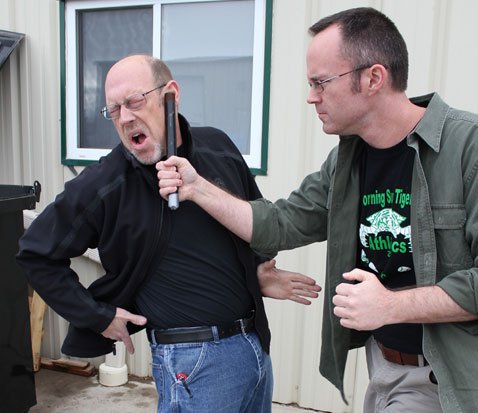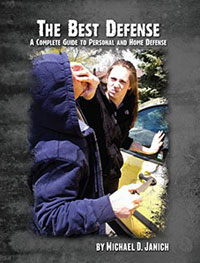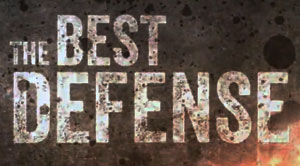Widgetized Section
Go to Admin » Appearance » Widgets » and move Gabfire Widget: Social into that MastheadOverlay zone
Earning Your Draw
 One of the most disturbing aspects of many traditional combat shooting curricula is the fact that they contradict themselves. At one moment, they will cite statistics that characterize the reality of violent attacks in a particular way, and then a moment later they’ll teach you a technique that works great on the range, but is completely inconsistent with the reality they just defined. And no topic suffers more from this duplicity of logic than close-quarters tactics.
One of the most disturbing aspects of many traditional combat shooting curricula is the fact that they contradict themselves. At one moment, they will cite statistics that characterize the reality of violent attacks in a particular way, and then a moment later they’ll teach you a technique that works great on the range, but is completely inconsistent with the reality they just defined. And no topic suffers more from this duplicity of logic than close-quarters tactics.
FBI Crime Statistics and the Nature of the Threat
Criminals are criminals. If we look at violent crimes committed against law enforcement officers, it makes sense that the criminals that attack them are the same ones that are most likely to victimize us. It also makes sense that, with the exception of grabbing a gun from an open-carry holster, the methods of attack they would use against police officers would be the same ones they’d use against us.
Based on this logic, many firearms trainers are quick to cite the FBI Law Enforcement Officers Killed and Assaulted report as an accurate reflection of the nature of criminal assaults. This annual report analyzes the circumstances surrounding the deaths of law enforcement officers in the U.S., including critical details such as the distances at which the officers killed by firearms were shot. For example, during the 10-year period 2000-2009, of the 490 officers killed with firearms, 247 (50%) were shot at distances of 0-5 feet and 89 (18%) were shot at distances of 5-10 feet. If we add the 6 officers killed during this period with contact-distance weapons, such as edged weapons, blunt instruments or personal weapons, we realize that 496 (93%) of the total 536 officers killed during this period were attacked at distances of 10 feet or less.
This disturbing statistic strongly suggests that the vast majority of lethal-force attacks occur at distances less than 10 feet. If we consider that only 118 (22%) of the officers fired their weapons and 91 (17%) attempted to use their weapons, it seems obvious that close-quarters weapon deployment and shooting would be the rule in firearms training, not the exception. If that’s the case, why does most defensive firearms training take place at seven yards? Based on the statistical probability of what’s most likely to happen, it doesn’t make sense.
Article continues below…
![]()
 |
THE BEST DEFENSEA Complete Guide To Personal And Home Defense
by Michael D. Janich, co-host of the hit TV series “The Best Defense”
|
![]()
Speed Rocks, Elbow Techniques, and the Typical Presentation
To give credit where credit is due, many defensive shooting programs do incorporate close-quarters shooting techniques. Unfortunately, many of the most commonly taught techniques—to include the default presentation or drawstroke—ignore the realities of actual street attacks.
If we accept the fact that most potentially lethal attacks occur at close range—specifically 0-10 feet—we must also accept that physical contact with an attacker is extremely likely. If he is armed with a contact-distance weapon like a knife or impact weapon, his goal is to achieve physical contact. With that probability in mind, it would seem that protecting yourself from injury, not just going for your gun, would be a high priority; but most close-quarters shooting tactics don’t reflect that.
Let’s say your attacker is armed with a piece of pipe. His most likely attack is going to be to swing that pipe as hard as he can at your head, probably with a forehand motion. Since most people are right handed, odds are that pipe will be aimed at the left side of your head and will begin its journey from just a few feet away. That’s your “problem.”
If your response is to “go to guns” with a standard drawstroke, you’re going to have a serious headache. Most commonly taught drawstrokes condition you to achieve a grip on the holstered gun while positioning your support hand in front of your abdomen. That way, once the gun is drawn, your hands can come together safely in a two-handed grip before extending toward the target. On the range, or against an attacker at a distance, that works great. On the street, however, you will pay the price for purposely conditioning yourself to drop your guard when attacked.
No problem, you say, as you know the “Speed Rock,” which was developed specifically for close-quarters situations. Instead of staging your support hand in front of your gut, you stick it to your chest or fling it behind your head while you lean back, draw, and shoot one-handed. Again, on the range, it looks cool and seems to solve the problem. Keeping your hand well out of the way of your gun minimizes the chances of shooting it; however, it also means that it isn’t doing anything to stop that pipe. As such, you still get whacked in the head. Sure, you’re leaning backward, so you’ve got a head start on falling down, but otherwise haven’t accomplished much.
You Need Empty-Hand Skills, Not Clichés
One of the biggest problems with firearms training is that it is regularly used as an excuse to not train in other skills. For example, if you mention counter-knife tactics around gun guys, you’ll inevitably hear something like, “Hell, I’d just shoot him. He brought a knife to a gunfight.”
Sure, clichés are amusing and cheesy action movies wouldn’t be the same without them. However, they are a lousy substitute for real training and a logical thought process—especially when they discourage you from filling gaping holes in your defensive skill set.
If you are attacked at close range, you are reacting to your assailant’s actions. Since action is always faster than reaction, you’re already behind the curve. As such, if you want to have a prayer of bringing your gun into play, you must not only survive the attack, you must do something decisive to create the opportunity to draw that gun. And the most efficient way to do that is to work with what you have immediately available: your empty-hand skills. In short, you must “earn” your draw.
The “Gas Station” episode of season 7 of The Best Defense is a graphic illustration of why you must have empty-hand fighting skills and why you must train to integrate those skills with your deployment and use of your gun. If you look in your tool box and all you see is a hammer, take the hint and start working on your unarmed fighting skills. Keep watching The Best Defense and come back here soon and we’ll show you how.
Stay safe,
Mike
About Michael Janich:
 Michael Janich is the co-host of The Best Defense and a noted personal-defense instructor, author of numerous books and instructional videos, and founder of the Martial Blade Concepts (MBC) system of edged-weapon tactics. A decorated U.S. Army veteran, Defense Intelligence Agency (DIA) intelligence officer, and former POW/MIA investigation team leader, Janich is also one of the most accomplished videographers in the tactical industry. He is currently the Special Projects Coordinator for the Spyderco knife company and a partner in Stay Safe Media.
Michael Janich is the co-host of The Best Defense and a noted personal-defense instructor, author of numerous books and instructional videos, and founder of the Martial Blade Concepts (MBC) system of edged-weapon tactics. A decorated U.S. Army veteran, Defense Intelligence Agency (DIA) intelligence officer, and former POW/MIA investigation team leader, Janich is also one of the most accomplished videographers in the tactical industry. He is currently the Special Projects Coordinator for the Spyderco knife company and a partner in Stay Safe Media.
To train with Janich and learn more about his classes, click here….






 MidwayUSA
MidwayUSA Ruger Firearms
Ruger Firearms SCCY Firearms
SCCY Firearms Streamlight
Streamlight Action Targets
Action Targets Gunsite Academy
Gunsite Academy
You must be logged in to post a comment Login